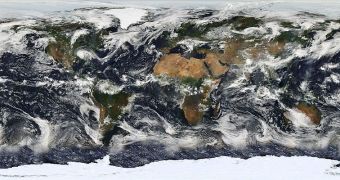According to a new investigation, it would appear that the long-held theory stating that tectonic plates carry water from the surface deep underground. The new work shows that water penetrates only about 400 kilometers in the mantle.
Our planet is made up of three large layers – the core, the mantle and the crust – which sit atop of each other in that order. The core and the crust are solid, whereas the mantle is viscous.
Due to motions caused in the mantle by the spins of the core, the crust cannot solidify altogether, but is instead fractured in a large number of segments called tectonic plates, that basically float on an ocean of magma.
As this happens, the plates can slam into each other, in a process that sees one of them gliding under the other. This is called subduction, and it is the process largely responsible for creating volcanoes and earthquakes.
For years, planetary scientists and geologists have believed that, as tectonic plates collided, the one that sunk back into the mantle carried with it water in fairly amounts.
But the new investigation, carried out by University of California in Riverside (UCR) distinguished professor of geology and geophysics Harry Green, shows that this theory is invalid.
The group he conducted in the new work revealed that water can only penetrate up to a depth of 400 kilometers under the planet's surface.
“The importance of this work is two-fold. Firstly, if deep slabs are dry, it implies that they are strong, a major current question in geophysics that has implications for plate tectonic models,” Green says.
“Secondly, even small amounts of water greatly reduce the viscosity of rocks; if water is not cycled deep into Earth, it means that mantle convection has not been as vigorous over time as it would have been with significant water,” he goes on to explain.
“Does this mean that Earth's deep interior must be dry? Not necessarily,” the expert write in a paper appearing in the latest issue of the esteemed scientific journal Nature.
“It is possible there are other ways – let's call them back roads – for water to penetrate the lower mantle, but our work shows that the 'super highway,' the subducting slabs, as a means for water to enter the lower mantle can now be ruled out,” Green explains.
The team conducted the new investigation with funding from the US National Science Foundation (NSF), SpaceRef reports.

 14 DAY TRIAL //
14 DAY TRIAL //